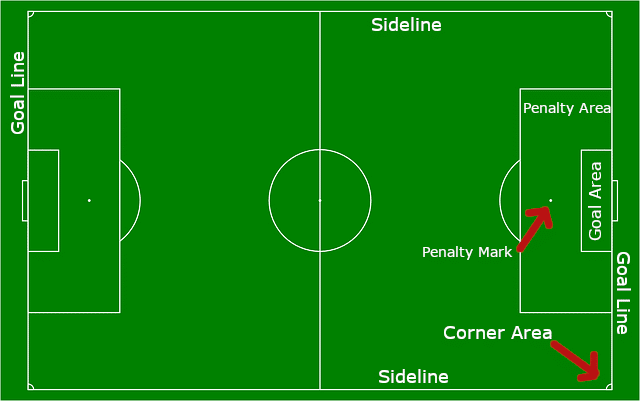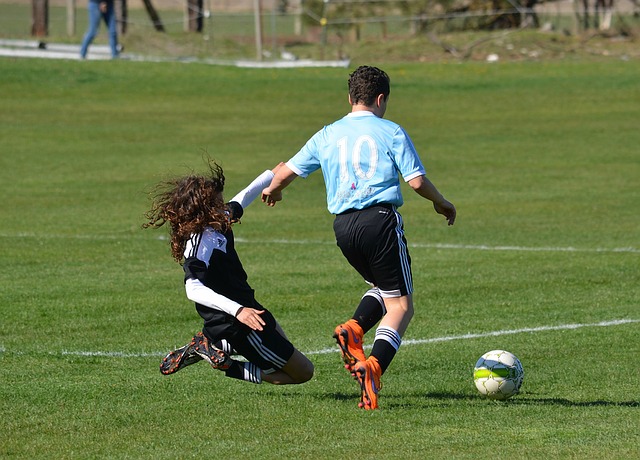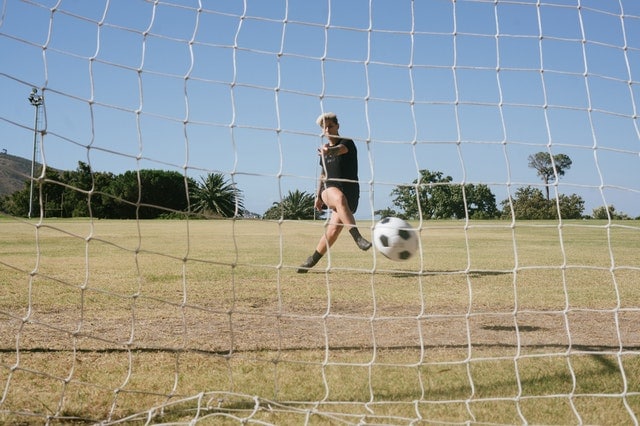So you want to play soccer but you don’t know the rules of the game. If that’s the case, then you have come to the right place. I’ll be happy to share all of the knowledge that I have gained about the soccer rules for the past 10 years with you in this little article. Stick around.
If you don’t know anything about soccer in general, you can start here.
Note that there are a lot of laws when it comes to soccer. Professional soccer laws decide what the soccer field dimensions should be, what the ball sizes should be and so much more. They even interfere in commercial advertising too.
Here’s the list of every single soccer law on the International Football Association Board(IFAB) website. If you are not interested in the whole thing, this article will list the most important rules that you need to know to be able to play or watch a soccer game with confidence.
Few things that you must know before we dive into the soccer rules.
- A referee runs inside the soccer field during the whole game in order to ensure that the players are abiding by the rules. The referee usually has other referees outside the soccer field to help him/her make the right choices during the game.
- The term ‘foul’ is used when a player breaks one of the rules during the match. When a foul happens, the referee uses his/her whistle to stop the game and then force the required action depending on the type of foul committed.
- During a soccer match, a referee holds 2 cards in their pocket, a yellow card and a red card. The referee can use the yellow card (as a warning) against a player who committed a foul that deserves a warning, and they can also use the red card against a player to kick them out of the game. If a player gets two yellow cards in one match, they’re kicked out of the game too. So 2 yellow cards is equivalent to 1 red card.
Alright that’s it, here are the most important soccer rules that you need to know before playing or watching any soccer match.
Please refer to this image whenever I use the name of any part of a soccer field down below

1- Players can’t touch the ball with their hands while the game is on.
This rule is widely known by both soccer and non soccer fans. Even if you know nothing about soccer at all, you might have heard that players aren’t supposed to touch the ball with their hands when the soccer match is on.
The ball shouldn’t touch the player’s whole arm, however the players are allowed to touch the ball with their shoulders.
There are a few exceptions to this rule however. A goalkeeper is allowed to touch the ball as long as he/she is standing inside the penalty area. Once the goalkeeper steps out of the penalty area, they won’t be able to touch the ball with their hand until they go back.
The goalkeeper is also not allowed to touch the ball with their hand inside the penalty area when one of their team players pass the ball to him/her. This rule prevent teams from wasting time by continually passing the ball back and forth between a goalkeeper and a player.
Sometimes non goalkeepers might be allowed to touch the ball too. If the player’s hands are very close to their body (hands aren’t spread out), and the ball hits the hand of the player without their intention, then the referee might not consider the handball to be a foul.
What happens after a player touches the ball with their hand?
If the player touches the ball with their hand inside their team’s penalty area, then the opponents get a penalty kick. I’ll explain penalty kicks later in this article.
However if they touch the ball outside of the penalty area of their team, then the opponents get a free kick. I’ll also explain free kicks later in this article.
2 – The ball must remain inside the rectangular field for the game to keep going
During a soccer match, the ball is always supposed to remain inside the boundaries of the field. Once the ball goes outside the rectangular field, the referee blows their whistle and the game stops.
What happens after the ball leaves the field?
Let’s name the 2 teams A and B.
If the ball crosses one of the sidelines, the team who didn’t touch the ball last gets a throw-in.
If the ball crosses team A’s goal line, then one of the following things happen:
- Team A gets a Goal kick if team B was the last to touch the ball
- Team B gets a Corner Kick if team A was the last to touch the ball
Throw-ins, Goal kicks and Corner Kicks will be explained later in this article.
3 – No violent actions allowed
During the soccer game, players will have to come in contact with each other thousands of times. These encounters shouldn’t be violent.

Players are not allowed to tackle each other violently, push each other, kick or attempt to kick each other, trip or attempt to trip each other and so on.
As you can tell, these rules are set in order to ensure the safety of the players during a soccer match.
If a player breaks any of these rules, the referee considers it to be a foul and depending on the severity of the foul, the referee might decide to give the offending player a yellow card or a red card.
If team A breaks one of these rules outside of the penalty area, team B gets a free kick. As you may have guessed, team B gets a penalty kick if team A breaks one of these rules inside the penalty area of their team.
4 – The offside rule
The offside rule was introduced to make sure that the players are discouraged to stay next to the opponent’s goal during the whole match and wait for the ball to come to them.
The offside rule states that a player on team A can’t take the ball from one of his/her teammates if he/she is closer to team B’s goal line than any other player from team B except the goalkeeper.
If a player from team A falls into the offside trap, then team B gets a free kick.
With that said, I conclude the list of the most important soccer rules that you need to know in order for you to play or watch a soccer game confidently.
What remains is that I explain the things that happen after the game stops due to a foul or a goal.
What is a free kick in soccer?
A free kick is given to a team when their opponent commits a foul outside of the penalty area. But what exactly is a free kick?
Here’s what happens when a free kick is awarded to team A:
- The ball is placed on the place where the foul occurred. There are very few exceptions to this rule however.
- One of team A’s players is selected in order to kick the ball after the whistle of the referee.
There are 2 types of free kicks. A direct free kick, and indirect free kick.
A direct free kick allows the player taking the free kick to kick the ball directly towards the opponent’s goal. On the other hand, an indirect free kick requires that the ball touches any other player on the field before it goes inside the opponent’s goal or else the goal isn’t counted.
Usually, direct free kicks are awarded for the more serious mistakes like handballs, tackles, and others. Indirect free kicks are awarded when a tiny break of rules occur.
You can tell whether the awarded kick is a direct one or not by looking at the hand of the referee. If the referee keeps their hand in the air until the ball touches one of the players after the kick is taken, then it’s an indirect kick. If the referee does not raise their hand at all during the free kick, then it’s a direct free kick.
I have mentioned that there are a few exceptions to where you should place the ball when your team is granted a free kick.
For example, If your team is granted a free kick inside your goal area, then you are allowed to place the ball anywhere inside your goal area in order to take the free kick.
As you can tell, this rule is to make sure that you don’t have to take a free kick somewhere very close to one of the goal posts, Else you’ll struggle to shoot the ball because the goal posts will be in the way. There are more exceptions that I won’t dive into in this article.
What is a penalty kick in soccer?
A penalty kick is awarded to team A if one of team B’s players commits a serious foul or a hand ball inside their penalty area.
A penalty kick converts to a goal most of the time.
Here’s what happens when a penalty kick is awarded to team A:
- The ball is placed on team B’s penalty mark
- One player from team A is chosen to take the penalty kick.
- All other players, except team B’s goalkeeper, should stand outside the penalty area until the chosen player touches the ball.
- Team B’s goalkeeper has to stand on the goal line during the penalty kick.
- Once the referee whistles, the chosen player kicks the ball towards team B’s goal and the goalkeeper tries to block the ball from entering the goal.

As mentioned before, penalty kicks are hard to miss, and if a very well known soccer player misses a penalty, then they might face a hard time on social media during the next few days.
What is a throw-in in soccer?
A throw-in is given to one of the competing teams when the ball crosses one of the sidelines of the football field. If team A touches the ball last before it crosses the sideline, then team B gets the throw-in, and vice versa.
Here’s what happens when team A is awarded a throw-in:
- One of team A’s players is selected to take the throw-in
- The selected player must take the throw-in from the place that the ball left the field
- The selected player throws the ball with both hands from behind and over their head to any of their teammates on the field
- The selected player can’t touch the ball again unless another player has touched the ball first
What is a goal kick in soccer?
A goal kick is awarded to team A when the ball crosses team A’s goal line immediately after touching one of team B’s players.
Here’s what happens when team A is awarded a goal kick:
- The ball is placed anywhere inside the goal area of team A
- Any selected player from team A (usually the goalkeeper is selected most of the time) can kick the ball forward to the field.
- All team B’s members must be outside the penalty area of team A until the selected player touches the ball.
What is a corner kick in soccer?
A corner kick is awarded to team A when the ball crosses team B’s goal line immediately after touching one of team B’s players.
Here’s what happens when team A is awarded a corner kick:
- The ball is placed in the corner area that is nearest to the place where the ball left the field.
- Any selected player from team A is allowed to kick the ball after the referee tells them to.
- Team B’s players must be at least 10 yards(9.15 meters) away from the corner arc until the selected player kicks the ball.
With that said, you now know what free kicks, penalty kicks, throw-ins, goal kicks and corner kicks are. One last rule that I want to mention here.
The player who is selected to take any of these kicks is not allowed to touch the ball again until any other player touches the ball. This is usually known as the 2-touch rule in soccer. Learn more about it here.
Who can score goals during a soccer match?
Any player on the field can score goals for their teams and against their teams too. Goalkeepers are also allowed to score goals.
There are many soccer players who have scored goals against their own teams by mistake. Such goals are referred to as “Own goals”, and there are many goalkeepers who have managed to score brilliant goals against their opponents too.
There you go, now you know most of the rules and actions in soccer, and you’re ready to play or watch your first soccer game fully confident that you know what you’re doing. Good luck in your next soccer game.

